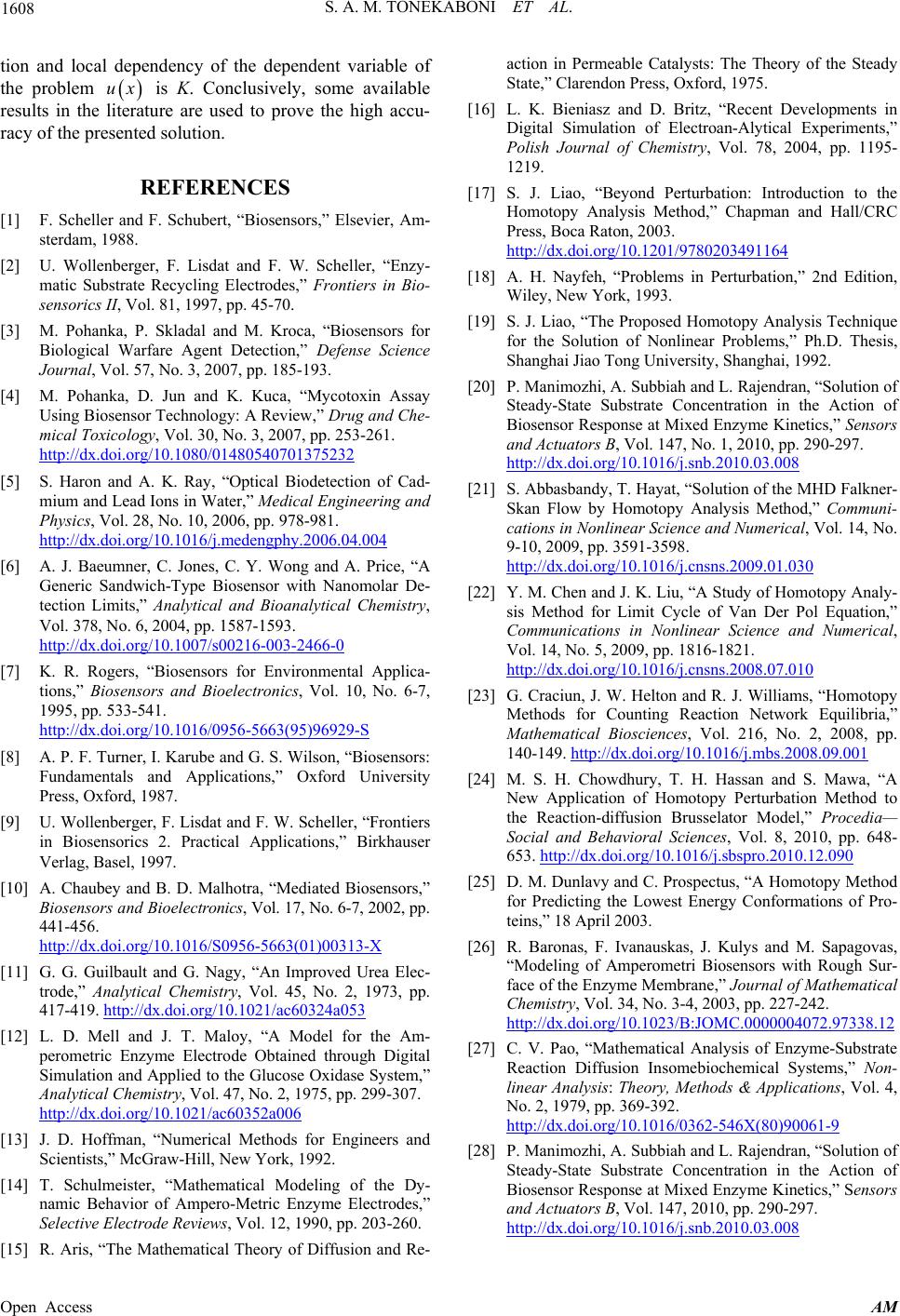
S. A. M. TONEKABONI ET AL.
1608
tion and local dependency of the dependent variable of
the problem
ux is K. Conclusively, some available
results in the literature are used to prove the high accu-
racy of the presented solution.
REFERENCES
[1] F. Scheller and F. Schubert, “Biosensors,” Elsevier, Am-
sterdam, 1988.
[2] U. Wollenberger, F. Lisdat and F. W. Scheller, “Enzy-
matic Substrate Recycling Electrodes,” Frontiers in Bio-
sensorics II, Vol. 81, 1997, pp. 45-70.
[3] M. Pohanka, P. Skladal and M. Kroca, “Biosensors for
Biological Warfare Agent Detection,” Defense Science
Journal, Vol. 57, No. 3, 2007, pp. 185-193.
[4] M. Pohanka, D. Jun and K. Kuca, “Mycotoxin Assay
Using Biosensor Technology: A Review,” Drug and Che-
mical Toxicology, Vol. 30, No. 3, 2007, pp. 253-261.
http://dx.doi.org/10.1080/01480540701375232
[5] S. Haron and A. K. Ray, “Optical Biodetection of Cad-
mium and Lead Ions in Water,” Medical Engineering and
Physics, Vol. 28, No. 10, 2006, pp. 978-981.
http://dx.doi.org/10.1016/j.medengphy.2006.04.004
[6] A. J. Baeumner, C. Jones, C. Y. Wong and A. Price, “A
Generic Sandwich-Type Biosensor with Nanomolar De-
tection Limits,” Analytical and Bioanalytical Chemistry,
Vol. 378, No. 6, 2004, pp. 1587-1593.
http://dx.doi.org/10.1007/s00216-003-2466-0
[7] K. R. Rogers, “Biosensors for Environmental Applica-
tions,” Biosensors and Bioelectronics, Vol. 10, No. 6-7,
1995, pp. 533-541.
http://dx.doi.org/10.1016/0956-5663(95)96929-S
[8] A. P. F. Turner, I. Karube and G. S. Wilson, “Biosensors:
Fundamentals and Applications,” Oxford University
Press, Oxford, 1987.
[9] U. Wollenberger, F. Lisdat and F. W. Scheller, “Frontiers
in Biosensorics 2. Practical Applications,” Birkhauser
Verlag, Basel, 1997.
[10] A. Chaubey and B. D. Malhotra, “Mediated Biosensors,”
Biosensors and Bioelectronics, Vol. 17, No. 6-7, 2002, pp.
441-456.
http://dx.doi.org/10.1016/S0956-5663(01)00313-X
[11] G. G. Guilbault and G. Nagy, “An Improved Urea Elec-
trode,” Analytical Chemistry, Vol. 45, No. 2, 1973, pp.
417-419. http://dx.doi.org/10.1021/ac60324a053
[12] L. D. Mell and J. T. Maloy, “A Model for the Am-
perometric Enzyme Electrode Obtained through Digital
Simulation and Applied to the Glucose Oxidase System,”
Analytical Chemistry, Vol. 47, No. 2, 1975, pp. 299-307.
http://dx.doi.org/10.1021/ac60352a006
[13] J. D. Hoffman, “Numerical Methods for Engineers and
Scientists,” McGraw-Hill, New York, 1992.
[14] T. Schulmeister, “Mathematical Modeling of the Dy-
namic Behavior of Ampero-Metric Enzyme Electrodes,”
Selective Electrode Reviews, Vol. 12, 1990, pp. 203-260.
[15] R. Aris, “The Mathematical Theory of Diffusion and Re-
action in Permeable Catalysts: The Theory of the Steady
State,” Clarendon Press, Oxford, 1975.
[16] L. K. Bieniasz and D. Britz, “Recent Developments in
Digital Simulation of Electroan-Alytical Experiments,”
Polish Journal of Chemistry, Vol. 78, 2004, pp. 1195-
1219.
[17] S. J. Liao, “Beyond Perturbation: Introduction to the
Homotopy Analysis Method,” Chapman and Hall/CRC
Press, Boca Raton, 2003.
http://dx.doi.org/10.1201/9780203491164
[18] A. H. Nayfeh, “Problems in Perturbation,” 2nd Edition,
Wiley, New York, 1993.
[19] S. J. Liao, “The Proposed Homotopy Analysis Technique
for the Solution of Nonlinear Problems,” Ph.D. Thesis,
Shanghai Jiao Tong University, Shanghai, 1992.
[20] P. Manimozhi, A. Subbiah and L. Rajendran, “Solution of
Steady-State Substrate Concentration in the Action of
Biosensor Response at Mixed Enzyme Kinetics,” Sensors
and Actuators B, Vol. 147, No. 1, 2010, pp. 290-297.
http://dx.doi.org/10.1016/j.snb.2010.03.008
[21] S. Abbasbandy, T. Hayat, “Solution of the MHD Falkner-
Skan Flow by Homotopy Analysis Method,” Communi-
cations in Nonlinear Science and Numerical, Vol. 14, No.
9-10, 2009, pp. 3591-3598.
http://dx.doi.org/10.1016/j.cnsns.2009.01.030
[22] Y. M. Chen and J. K. Liu, “A Study of Homotopy Analy-
sis Method for Limit Cycle of Van Der Pol Equation,”
Communications in Nonlinear Science and Numerical,
Vol. 14, No. 5, 2009, pp. 1816-1821.
http://dx.doi.org/10.1016/j.cnsns.2008.07.010
[23] G. Craciun, J. W. Helton and R. J. Williams, “Homotopy
Methods for Counting Reaction Network Equilibria,”
Mathematical Biosciences, Vol. 216, No. 2, 2008, pp.
140-149. http://dx.doi.org/10.1016/j.mbs.2008.09.001
[24] M. S. H. Chowdhury, T. H. Hassan and S. Mawa, “A
New Application of Homotopy Perturbation Method to
the Reaction-diffusion Brusselator Model,” Procedia—
Social and Behavioral Sciences, Vol. 8, 2010, pp. 648-
653. http://dx.doi.org/10.1016/j.sbspro.2010.12.090
[25] D. M. Dunlavy and C. Prospectus, “A Homotopy Method
for Predicting the Lowest Energy Conformations of Pro-
teins,” 18 April 2003.
[26] R. Baronas, F. Ivanauskas, J. Kulys and M. Sapagovas,
“Modeling of Amperometri Biosensors with Rough Sur-
face of the Enzyme Membrane,” Journal of Mathematical
Chemistry, Vol. 34, No. 3-4, 2003, pp. 227-242.
http://dx.doi.org/10.1023/B:JOMC.0000004072.97338.12
[27] C. V. Pao, “Mathematical Analysis of Enzyme-Substrate
Reaction Diffusion Insomebiochemical Systems,” Non-
linear Analysis: Theory, Methods & Applications, Vol. 4,
No. 2, 1979, pp. 369-392.
http://dx.doi.org/10.1016/0362-546X(80)90061-9
[28] P. Manimozhi, A. Subbiah and L. Rajendran, “Solution of
Steady-State Substrate Concentration in the Action of
Biosensor Response at Mixed Enzyme Kinetics,” Sensors
and Actuators B, Vol. 147, 2010, pp. 290-297.
http://dx.doi.org/10.1016/j.snb.2010.03.008
O
pen Access AM